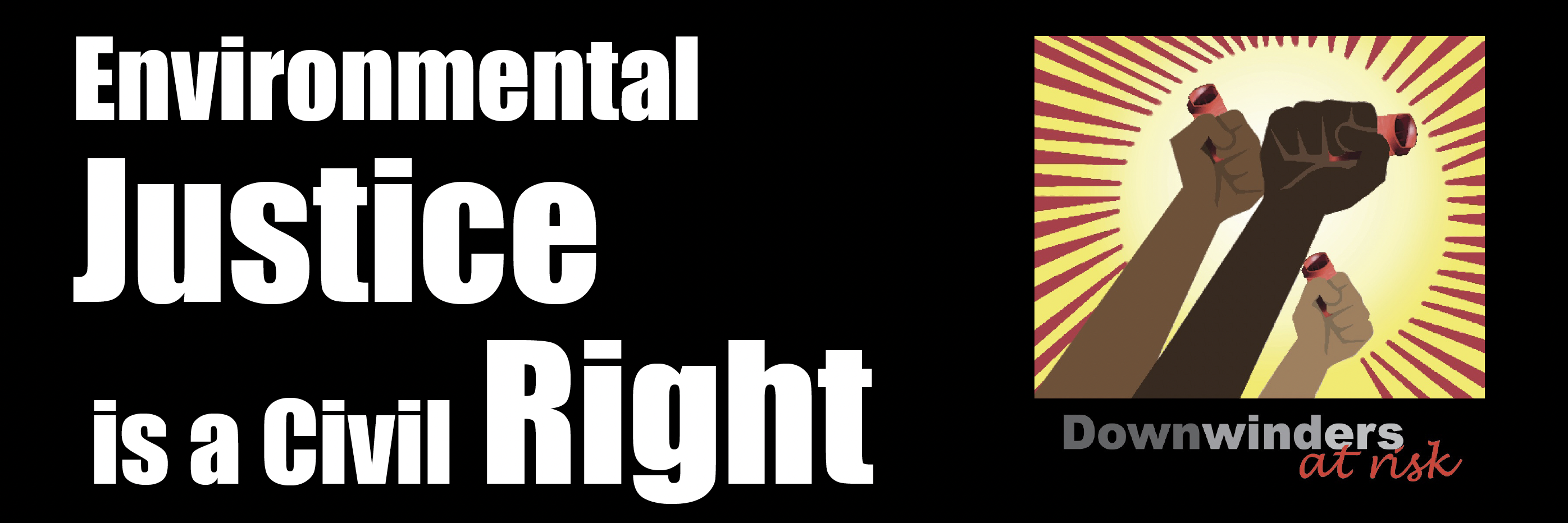Fracking
Thank You. Citizens Might Have Just Saved The Local Air Planning Process…From Itself
 A year from now, last Thursday' meeting in Arlington may be seen as a turning point.
A year from now, last Thursday' meeting in Arlington may be seen as a turning point.
Local residents refused to let the air quality planning process die, showing up in numbers that forced officials to switch to a larger room, and making sure their opposition to another state "do-nothing" air plan was heard loud and clear.
Their participation had already changed the day's agenda. Included was a breakthrough UNT study that directly challenges the Texas Commission on Environmental Quality's claim that natural gas emissions don't increase DFW smog.
UNT's Dr. Kuruvilla John's presentation of the new study received quite a bit of media coverage, before, during, and after Thursday's meeting. You can find some of the best coverage by clicking on the links below.
UT-Austin Study Reveals "Underestimates"
Dr. John's presentation influenced another researcher's slide show as well. Scheduled to speak about older, more generic ambient air measurements for ozone, Dr. David Allen of UT Austin instead presented more recent research into gas pollution as well.
Overlooked in the debut of the UNT study, Allen's constant monitoring of one drill site in Fort Worth revealed that the TCEQ was underestimating emissions from the pneumatic valves at the site by 159%.
That was news to both citizens and TCEQ, who said they hadn't looked at Allen's research and hadn't corrected their inventories to account for such underestimates. Valves like these are powered by natural gas, are quite numerous on gas equipment, and account for a large percentage of VOCs released from a fracking site.
A Better Picture of Oil and Gas Pollution
Citizen cross-examination of TCEQ staff members present at the meeting also revealed a different look at the volume of Oil and Gas industry pollution in the 10-county DFW "non-attainment area"
Up to Thursday, TCEQ was dispersing Oil and Gas pollution across several categories, making it impossible to show the true total impacts.
Here's an example of the way TCEQ likes to present the info:
SOURCES OF SMOG-FORMING NITROGEN OXIDE POLLUTION (NOx)
IN DFW's NON-ATTAINMENT AREA
1. "On Road" vehicles 113.21 tons per day
2. "Non-Road" vehicles" 39.87 tpd
3. "Area" 30.76 tpd
4. "Other Point Sources" 24.95 tpd
5. "Locomotives" 18.90 tpd
6. "Cement Kilns" 17.60 tpd
7. "Electric Utilities" 15.02 tpd
8. Oil and Gas Production 12.21 tpd
9."Airports" 11.77 tpd
10. Oil and Gas Drill Rigs 5.83 tpd
TOTAL 290.12 tpd
This makes it look like Oil and Gas pollution is not that big a deal.
But it turns out TCEQ is hiding 28.44 tpd of NOx gas compressor pollution in the "Area" and "Other Point Source" categories.
This was brought out in questioning on Thursday. Once you add these figures to the other Oil and Gas emission numbers spread out over different categories, this is what you get:
SOURCES OF SMOG-FORMING NITROGEN OXIDE POLLUTION (NOx)
IN DFW's NON-ATTAINMENT AREA
1. "On Road" vehicles 113.21 tpd
2. Oil and Gas Industry 46.48 tpd
3. "Non-Road" vehicles 39.87 tpd
4. "Locomotives" 18.90 tpd
5. "Cement Kilns" 17.60 tpd
6. "Area" 15.93 tpd
7. "Electric Utilities" 15.02 tpd
8. "Other Point Sources" 11.34 tpd
9. "Airports" 11.77 tpd
TOTAL 290.12
(Earlier today we put out an e-mail alert that left 10 tons off the "Area" category in this second chart, greatly affecting its ranking. That mistake is corrected in this version of the chart and we apologize for any confusion that might have caused)
When you quit playing the state's shell game with Shale pollution, the Oil and Gas industry becomes the region's second largest source of NOx pollution – the kind of pollution TCEQ says is the main driver of smog in DFW (not even counting all the pollution from O&G fracking trucks still hiding in the "On Road" category).
There have been control measures for cars to reduce NOx. There have been controls on heavy duty equipment and trucks to reduce NOx. There have been new controls on locomotives to reduce NOx pollution. There have been controls on airport ground equipment to reduce NOx pollution. There's even been middling controls to reduce the NOx from the Midlothian cement kilns. But where's the controls to reduce NOx from the Oil and Gas industry – the one source in this list that hasn't had the same kind of regulatory attention? Good question – save it for next time.
Citizen Participation is Crucial
This is the kind of close examination the TCEQ hopes to avoid by limiting debate on this new clean air plan, scheduled to be submitted to EPA by July next year. And it's exactly why citizens need to keep showing up.
Because of the momentum and interest coming out of Thursday's meeting, citizens also got the next scheduled pow-wow of the local air planning process moved up to late May or early June instead of waiting until July.
We're already taking suggestions for what you want to see on that agenda, so don't be shy. And thank you again for restoring some tiny amounts of integrity into a process that's been swamped by Rick Perry's indifference.
You're making a difference, and that's all anybody can do. This last Thursday it was a big difference. Let's try to do the same in May.
Some Coverage of Thursday's Air Planning Mtg.
Channel 8: "UNT researchers say fracking a contributor to North Texas smog problem"
Texas Observer: "Studies: Links Between Fracking and Smog Pollution Stronger Than State Claims"
Star-Telegram: "Natural Gas Production Contributing to Higher Ozone Levels, study Finds"
Denton Record Chronicle: "Officials: No New Plans to Clean Up Air"
HOW YOU CAN SAY "THANK YOU" BACK
Here's what Downwinders at Risk did this past week to make sure Thursday's air quality meeting wasa success:
1) Pressed for and got the UNT study linking fracking to smog on the meeting agenda after being told it would not be included.
2) Sent out releases to the media advertising the UNT presentation.
3) Sent out alerts to you and others to let you know about the new UNT study and the meeting itself.
4) Sent out a "Citizens' Guide to the Meeting" so you could be prepared for Thursday.
5) Showed-up at Thursday's meeting with handouts showing the lack of air quality progress in DFW and the lack of a complete plan by TCEQ
6) Used our questions to reveal how TCEQ was hiding Oil and Gas industry pollution totals in their data
7) Pressed for and got an earlier "next meeting" of the local air quality planning group
8) Sent out this follow-up so that everyone knows what went on and what the news is from the meeting
A local forum for clean air issues was about to disappear.
Only the last month's mobilization of citizens prevented that from happening on Thursday.
Who began that mobilization?
We did.
We really need your financial help to keep doing this. We don't get state or national funding – just local money from people like yourself.
Thanks. We very much appreciate it.
We Won a Small Victory – Now Come Take Advantage of It
 This is why citizen participation matters.
This is why citizen participation matters.
Last week, local officials were balking at reserving a slot at next Thursday's regional air planning meeting for a presentation by UNT researchers on how gas industry emissions from the Barnett Shale could be adding to DFW's chronic smog.
After reading about the UNT research in the Denton Record Chronicle, Downwinders at Risk and State Representative Lon Burnam specifically asked the local Council of Governments to include the UNT work on the agenda.
At first, we were told that there was already one technical presentation scheduled for the meeting and there wouldn't be any time for a second.
That struck us as strange, since in the past, every such meeting has always had more than one technical presentation.
When we pointed this out in an e-mail with links to past meeting agendas to prove the point, we quickly got a different response. Suddenly, there would be time for the UNT presentation.
That wasn't so hard was it? All it took was a little logical push back. But if we hadn't supplied it, Thursday would be looking a lot different.
Now, we're asking you to please come and help us push back a little more.
State environmental officials are on record as saying the air pollution from gas mining and production in the Barnett Shale is not adding to DFW's smog.
A lot of us think otherwise.
Come next Thursday, on the 17th, you can listen to the new UNT research on fracking air pollution and ask Texas Commission on Environmental Quality officials directly what makes them so sure that gas pollution isn't hurting local air quality.
Because the format of these regional clean air meetings are now so informal, anyone in the audience can ask questions of a presenter. That means you – if you show up.
It doesn't matter if you don't know the technical lingo. This is all about wind direction, weather, and things that pollute. There are no stupid questions.
The new anti-smog plan that the state is building needs all the public scrutiny it can get. It needs tough examination by people who care about clean air and the truth.
Next Thursday, you can help us put the state on the spot.
This is the first opportunity in 2014 to speak up and sound off about our decades-long smog problem. Don't let the TCEQ leave town without hearing from you.
We fought and won the right for you to listen to this research because we thought it was important. Won't you please come and take advantage of this victory?
We need a good showing to prove DFW residents are still mad about breathing dirty air.
NEXT THURSDAY, APRIL 17th
10 am to 12pm
North Central Texas Council of Government headquarters
616 Six Flags Drive
(After the meeting, State Representative Lon Burnam and Downwinders will be hosting a lunch time de-briefing, location to be decided, so stay tuned.)
Look, we know this is a small victory. But state officials don't want to talk about how gas industry pollution may be making our local smog worse, even though there's evidence that it is.
That's exactly why we think we need to keep bringing it up.
Winning the right to hear a new scientific presentation on the connection between gas pollution and smog may not seem like much of a win, but it is when the Powers-That-Be don't want you to hear it.
We know that small victories like this can lead to larger successes.
In the 1990's the same state agency that's now denying gas pollution has any impact on DFW smog was saying exactly the same thing about the Midlothian cement plants.
It took lots of push back from citizens who knew better before we got the state to admit it was wrong.
Now, Ellis County is in the DFW non-attainment area and the cement plants have controls on them they would otherwise never have.
We need the same effort in 2014 to show the state is as wrong about gas industry pollution as it was about the cement plants.
Right now, Downwinders is the only group committed to organizing citizens around clean air issues in DFW.
But we just lost a funding source that was critical to us and we need your help to keep the pressure on. This money paid for staff work in the field.It's very easy to give securely online here, or you can send checks to our P.O. Box at the bottom of the page.
We really need your help. Thank you.
A Barnett Shale Manifesto…From Austin
 Sometimes it takes a perspective above the grind of trench warfare to give you a better sense of what the entire battlefield looks like. That's what UT Law Professor Rachel Rawlins has done for Barnett Shale activists with the recent publication of her article "Planning for Fracking on the Barnett Shale: Urban Air Pollution, Improving Health Based Regulation, and the Role of Local Governments" in the new Virginia Environmental Law Review.
Sometimes it takes a perspective above the grind of trench warfare to give you a better sense of what the entire battlefield looks like. That's what UT Law Professor Rachel Rawlins has done for Barnett Shale activists with the recent publication of her article "Planning for Fracking on the Barnett Shale: Urban Air Pollution, Improving Health Based Regulation, and the Role of Local Governments" in the new Virginia Environmental Law Review.
Don't let the academic title fool you. This is a call for a radically new approach to how communities in Texas regulate the risks of fracking, and every other type of heavy industry. We put the link up for the piece on our Facebook page on Saturday based on a quick reading of its commentary on the Flower Mound cancer cluster, but it's more, so much more than that. Among other things, it's a comprehensive rebuttal of every claim of safety and well-being ever issued by the industry or state authorities about the health of residents living in the Barnett Shale, of which the Flower Mound case is only one example. Rawlins has produced a one-stop catalog of each major air pollution health controversy in the Barnett since concerns began to grow in the last decade, with an almost 30-page review of why no industry or government-sponsored study of fracking pollution and its health effects is a satisfactory response to those concerns. Want to convince your local officials that fracking isn't as safe as it's touted? Here's the staggering blow-by-blow commentary to do it.
But all of that documentation is presented in service to making the point that current state and federal regulation of fracking is failing to protect public health, both in design and in practice. Professor Rawlins' solution to this problem is not to give the state and federal government more power to regulate the gas industry. No, it's to turn the current regulatory framework upside down and give more power to local governments to do the things that the state and federal government should be doing.
In making this recommendation, she echoes the strategy that's been driving Downwinders since it was founded – that the best way to regulate pollution problems is at the local level where the most harm is being done, and it should be directed by the people being harmed. This is what drove our Green Cement campaign that closed the last obsolete wet cement kiln in Texas. This is what fueled our campaign to close down the trailer park-come-lead smelter in Frisco. And it's what was behind the recent Dallas fights over drilling. In each case, it wasn't Austin or Washington DC that was the instrument of change – it was local governments, pressed by their constituents, flexing their regulatory powers. The same thing is driving activists in Denton who are organizing the ban fracking petition drive and vote.
This strategy avoids battles where industry is strongest – in the halls of the state capitol and in DC, where citizens are outspent millions to one. Instead, it takes the fight to neighborhoods where the harm is being done or proposed, where people have the most to lose, where the heat that can be applied to elected officials is more intense. Citizens will still get outspent, but the money doesn't seem to buy corporations as much influence among those actually breathing the fumes of the drilling site, or smokestack.
Particularly now, with corporate-friendly faux-Tea Party types in control of state government and the House of Representatives in DC, there is little room for grassroots campaigns to make a difference by passing new legislation. Even if by some miracle a few bills did pass, their enforcement would be up to the same state or federal agencies that are currently failing citizens. Local is more direct, and more accountable. Professor Rawlins agrees, and spends most of the rest of her 81-page journal article citing the ways in which local control of fracking in the Barnett Shale is hampered by the out-dated top-down approach to regulation, and what should be done to fix that.
Included in her recommendations are two long-term Downwinders projects: Allowing local governments to close the "off-sets" loophole for the gas industry that exempts them from having to compensate for their smog-forming pollution in already smoggy areas like DFW, and creating California-like local air pollution control districts that could set their own health based exposure standards and pollution control measures without having to go through Austin or DC.
If there's a single major fault in Rawlins's analysis, it's that she believes more local control of pollution risks is itself dependent on action by an unwilling state government. But Downwinders and others have shown that isn't true. Our most significant and far-reaching victories – from the closing of the Midlothian wet kilns to the new Dallas drilling ordinance – have all taken place while Rick Perry was Governor and the state legislature was in the hands of our opponents. We did these things despite Austin, not because we had its permission. Local zoning laws, local permitting rules, local nuisance acts, and other local powers are under-utilized by both residents and their elected officials when it comes to pollution hazards.
The same is true now of Downwinders' off-sets campaign aimed at the gas industry. We think we've found a way to avoid the "preemption" argument that would keep local governments from acting on smog pollution from gas sources by aiming the off-sets at Greenhouse gases – an area of regulation Texas is loathe to enter. By targeting GHG reduction, we also reduce a lot of toxic and smog-forming air pollution. It's a back door way, but it accomplishes the same goal. It's going to be up to Texas activists to sew similar small threads of change through an otherwise hostile political environment.
Even given that flaw, Professor Rawlins' introduction to her article is the most concise summary of the air pollution problems caused by gas mining and production in the Barnett, as well as the most credible call to action for a new way of doing business there. Here it is reprinted in full for your consideration:
In the last decade hydraulic fracturing for natural gas has exploded on the Barnett Shale in Texas. The region is now home to the most intensive hydraulic fracking and gas production activities ever undertaken in densely urbanized areas. Faced with minimal state and federal regulation, Texas cities are on the front line in the effort to figure out how best to balance industry, land use, and environmental concerns. Local governments in Texas, however, do not currently have the regulatory authority, capacity, or the information required to closet he regulatory gap. Using the community experience on the Barnett Shale as a case study, this article focuses on the legal and regulatory framework governing air emissions and proposes changes to the current regulatory structure.
Under both the state and federal programs, the regulation of hazardous air emissions from gas operations is based largely on questions of cost and available technology. There is no comprehensive cumulative risk assessment to consider the potential impact to public health in urban areas. Drilling operations are being conducted in residential areas. Residents living in close proximity to gas operations on the Barnett Shale have voiced serious concerns for their health, which have yet to be comprehensively evaluated. Given the complexityof the science, and the dearth of clear, transparent, and enforceable standards, inadequate studies and limited statistical analysis have been allowed to provide potentially false assurances. The politically expedient bottom line dominates with little attention paid to the quality of the science or the adequacy of the standards.
Determining and applying comprehensive health-based standards for hazardous air pollutants has been largely abandoned at the federal level given uncertainties in the science, difficulties of determining and
measuring “safe” levels of toxic pollutants, and the potential for economic disruption. Neither the state nor the federal government has set enforceable ambient standards for hazardous air pollutants.Identifying cumulative air pollution problems that may occur in urban areas, the State of California has called upon local governments to identify “hot spots” and to consider air quality issues in their planning and zoning actions. In Texas, however, preemption discussions dominate the analysis. Any local government regulation that might provide protection from toxic air emissions otherwise regulated by the State must be justified by some other public purpose.
Texas should consider authorizing and encouraging local level air quality planning for industrial activities, similar to what California has done. Care should be taken to separate these facilities from sensitive receptors and “hot spots” that may already be burdened with excessive hazardous air emissions. Given the difficulty of the task, there is also an important role for the state and federal governments in working to establish ambient standards for hazardous air pollutants, as well as standards for health based assessment and public communication. The uncertainty inherent in any of these standards should be made clear and accessible to local governments so that it may be considered in making appropriate and protective land use decisions. Texas should consider allowing local governments to have the power to establish ambient air quality standards, emissions limitations, monitoring, reporting, and offsets for hazardous air pollutants, following the model applied to conventional air pollutants pursuant to the federal program.
Professor Rawlins' article provides Barnett Shale activists with a new map to guide them toward more effective action. We'd all do well to study it and pick local battles that promise to contribute toward its realization.
Can You Spot the Mistake in This Map?
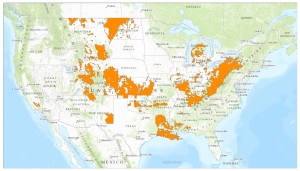 Here's why there's a missing big orange splotch….or two….or three, in Texas in this new national map of oil and gas well concentration.
Here's why there's a missing big orange splotch….or two….or three, in Texas in this new national map of oil and gas well concentration.
New UNT Study-In-Progress Links Gas Pollution to Persistent DFW Smog
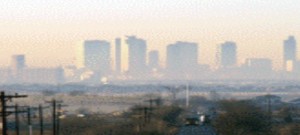 This is why it's important for citizens to have real scientific horsepower.
This is why it's important for citizens to have real scientific horsepower.
DFW has a smog problem. It's not as bad as it used to be, but it's still at unsafe and illegal levels. And for the last four or five years, the air quality progress that should have been made has been stymied. Despite almost all large sources of smog-producing pollution being reduced in volume, our running average for ozone is actually a part per billion higher than it was in 2009.
Many local activists believe this lack of progress is due to the huge volumes of smog-producing air pollution being generated by the thousands of individual natural gas sites throughout the DFW region itself, as well as upwind gas and oil plays. In 2012, a Houston-based think tank released a report showing how a single gas flare or compressor could significantly impact downwind smog levels for up to 5 mile or more. Industry and the Texas Commission on Environmental Quality say no, gas sources are not significant contributors to DFW smog. In fact, during this current round of planning, the state has gone out of its way to downplay the impact of gas pollution, including rolling back previous emission inventories and inventing new ways to estimates emissions from large facilities like compressor stations.
Into this debate steps a UNT graduate student offering a simple and eloquent scientific analysis that uses the state's own data on smog to indict the gas industry for its chronic persistence in DFW – especially in the western part of he Metromess, where Barnett Shale production is concentrated.
On Monday night Denton Record-Chronicle reporter Peggy Heinkel-Wolfe gave a summary of a presentation on local air quality she'd sat through that day at UNT:
"Graduate student Mahdi Ahmadi, working with his advisor, Dr. Kuruvilla John, downloaded the ozone air monitoring data from the Texas Commission on Environmental Quality back to 1997, a total of more than 6.5 million data points, he said, and has been studying it for the past four months.
Ahmadi wanted to explore a basic question underlying a graphic frequently distributed by the TCEQ that shows gas wells going up in DFW as ozone goes down, which suggests in a not-very-scientific-at-all way, that the increasing number of gas wells is having no effect on the ozone.
Ahmadi adjusted for meteorological conditions to determine how much ozone DFW people are making and where. Such adjustments have been explored by others to understand better the parts of ozone-making we can control, because we can’t control the weather. He used an advanced statistical method on the data, called the Kolmogorov-Zurbenko filter, to separate the effects of atmospheric parameters from human activities.
According to the results, the air monitoring sites surrounded by oil and gas production activities, generally on the west side of DFW, show worse long-term trends in ozone reduction than those located farther from wells on the east side of DFW.
His spatial analysis of the data showed that ozone distribution has been disproportionally changed and appears linked to production activities, perhaps an explanation why residents on the western side of DFW are seeing more locally produced ozone, particularly since 2008.
Ahmadi's results are not definitive, and the paper he's writing is still a work-in-progress. But he's asking the right questions, and challenging the right unproven assumptions. He's at least put forth an hypothesis and is trying to prove or disprove it. He's using science. TCEQ's approach is all faith-based.
Anything that takes the focus off vehicle pollution is anathema to Austin and many local officials who want to pretend that industrial sources of air pollution don't impact the DFW region enough to make a difference so they don't have to regulate them. If there's a guiding principle to TCEQ's approach to this new clean air plan, due in July 2015, it's to avoid any excuse for new regulations while Rick Perry is running for President. The agency isn't interested in doing any kind of science that might challenge that perspective – no matter how persuasive. After all, you're talking about a group that doesn't believe smog is bad for you. TCEQ doesn't want to know the truth. It can't handle the truth. It's got an ideology and it's stickin' to it.
So it's up to young lowly graduate students from state universities armed only with a healthy sense of scientific curiosity to step up and start suggesting that the Emperor's computer model has no clothes, and offering up alternative scenarios to explain why DFW air quality is stuck in neutral. It turns out, just doing straight-up classroom science is enough to threaten the fragile House of Computer Cards with which the state's air plan is being built.
Perhaps equally as ominous for the success fo any new clean air plan is Ahmadi's discovery that ozone levels in DFW have been during the winter time, or "off-ozone-season." There could be a new normal, higher background level of smog affecting public health almost year round.
Mahdi Ahmadi's study is just one of the many that need to be done to construct an honest clean air plan for DFW, but it shows you what a curious mind and some computing power can do. Citizens can't trust the state to do the basic science necessary as long as the current cast of characters is running the show in Austin. EPA won't step in and stop the farce as long as TCEQ can make things work out on paper. If the scientific method is going to get used to build a better DFW clean air plan, it's going to have to be citizens who apply it.
What are the Pollution Impacts of the New Liquified Natural Gas Plant Announced for Midlothian?
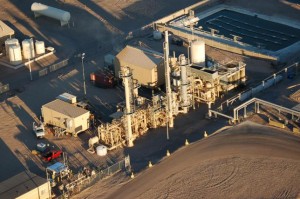 If you're already hosting the three or four largest single sources of air pollution in the entire region you need new large industrial sources of crap like a hole in the head. Likewise, if you've already violated the Clean Air Act for decades the last thing you need are new large sources of smog-producing pollution. But that's exactly what's happening with the announcement last week that a new Liquified Natural Gas (LNG) plant is being proposed for Midlothian's Railport Industrial Park, located between Midlothian and Venus on Highway 67, directly below, and upwind, of the Dallas-Tarrant County line.
If you're already hosting the three or four largest single sources of air pollution in the entire region you need new large industrial sources of crap like a hole in the head. Likewise, if you've already violated the Clean Air Act for decades the last thing you need are new large sources of smog-producing pollution. But that's exactly what's happening with the announcement last week that a new Liquified Natural Gas (LNG) plant is being proposed for Midlothian's Railport Industrial Park, located between Midlothian and Venus on Highway 67, directly below, and upwind, of the Dallas-Tarrant County line.
Applied Natural Gas Fuels (ANGF) put out a press release on March 21st that touted the purchase of 31 acres for a facility that would house "five liquefaction units, each able to produce 86,000 gallons of fuel daily, and total onsite storage of 1.5 million LNG gallons."
"In preparation of building the facility, which was announced last September, ANGF has purchase orders for all long-lead time items, such as storage tanks, production skids and electric motors and compressors, the company said.
The plant seeks to supply both road transportation and other off-road high-horsepower applications, such as rail, marine, mining, remote power generation and oilfield exploration/production (E&P) operations."
LNG plants take natural gas and cool it to minus 260 degrees F, at which point it becomes a liquid. This allows the industry to be able to store and move it compactly. It's been described as reducing the air out of a beach ball to shrink it to the size of a ping pong ball. But it also greatly increases the chances of accidents. If there's a leak or spill from a tank or pipeline the LNG would convert back to a gas. As it diluted with air, the natural gas/air mixture could become potentially explosive if the concentration of natural gas in air reached between 4% and 17%. In this range, any source of ignition (cell phone, cigarette lighter, attic fan, light switch, auto or boat engine spark plug, carpet spark, etc.) could ignite a vapor cloud and impact a large area.
ANGF already operates an LNG plant in Topock, Arizona, only three miles on the other side of California's border – and tougher regulations. At the same time it's building its new facility in Texas, the company is also doubling the capacity of the Arizona plant. According to an online document about the company's current operations from the Southern California Air Pollution Control District,
"…the gas must be stripped of impurities until it's over 98% methane. Co2, H2S, other sulfur components, moisture, mercury, and particles are stripped via acid gas removal and disposal, gas dehydration, mercury removal, and particle filtration…. The emissions associated with these processes include CO, VOC, SOx, NOx, H2S, particulates, and many toxic organic compounds."
That's Carbon Monoxide, a poison everyone's familiar with, Volatile Organic Compounds, a smog-producing class of chemicals like Benzene and Toluene, many of which are also carcinogenic, Sulfur Dioxide, a respiratory irritant which also causes acid rain, Nitrogen Oxide, a smog-producing respiratory irritant, PM pollution that's been linked to everything from heart attacks to Parkinson's, Mercury, a notorious neurotoxin, and oh yes, Hydrogen Sulfide, or "sour gas," a highly toxic and flammable poison that causes pulmonary edema at low concentrations and death at high ones.
We don't have specific annual volumes of those pollutants for the Midlothian plant yet, and may never get them if the facility receives a standard permit with only an upper ceiling of emissions, but LNG plants use a lot of energy, and therefore have the potential to emit a lot of air pollution. It appears that the Midlothian plant will be burning natural gas for its power, including huge gas turbine compressors. At much larger LNG export plants proposed for the coasts, these compressors have been the subject of a lot of concern. Last November, a Canadian wildlife conservation group released a report on a string of proposed LNG plants for British Columbia that estimated the facilities would be burning most of the gas used in the Province,
"The report, Air Advisory: The Air Quality Impacts of Liquefied Natural Gas Operations Proposed for Kitimat, B.C., concluded LNG plants permitted to operate primarily with natural gas will collectively burn 60 per cent of all the natural gas burned annually in B.C.
The report concluded nitrogen oxide emissions from the LNG plants would increase 500 per cent above existing levels. Nitrogen oxide emissions create acid rain, which harms waterways and fish and creates smog, which causes respiratory problems for children and the elderly, the report states.
The report also concluded natural gas driven LNG plants will increase emissions in the Kitimat area of volatile organic compounds, carbon monoxide and sulphur dioxide."
As a result of these kinds of concerns, the Canadian government committed to spending over a half million dollars on a study of how the gas industry will affect air quality in this part of British Columbia.
The Midlothian plant will be much smaller, put its impact on local and regional air quality could still be substantial depending on the design and technology. Industrial Hydrogen Sulfide and VOCs are not something you want wafting into your backyard, and anything that makes more smog is bad news for the entire DFW region.
Locating in Railport – itself a piece of heavy-metal contaminated ranch property bought and developed by TXI to prevent further liability issues – the LNG plant adds to the inventory of polluters that call Midlothian home. Three large cement plants, a steel mill, a gas power plant, and other smaller entities have made sure the city is the closest thing to a DFW Ship Channel that we have. Collectively, these facilities emit a kind of super plume of air pollution that spews north into the middle of the Metromess during most of the year. If you live anywhere from SW Dallas to NW Tarrant County, you're already breathing the pollution from Midlothian industry. How much the ANGF facility will add to that plume is not yet known, but any increase is going in the wrong direction. Stay tuned.
Waxahachie’s Magnablend Settles Lawsuit with Injured Employee
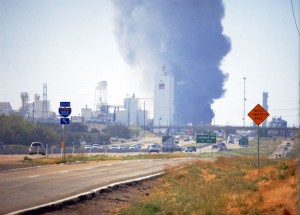 Once you read the damning testimony of Magnablend's own employees in the Waxahachie Daily Light coverage of the trial, you only wondered how long it would take for the company to settle with James Barron, who claimed the October 3rd explosion and fire at the chemical blending facility had resulted in permanent neurological damage.
Once you read the damning testimony of Magnablend's own employees in the Waxahachie Daily Light coverage of the trial, you only wondered how long it would take for the company to settle with James Barron, who claimed the October 3rd explosion and fire at the chemical blending facility had resulted in permanent neurological damage.
The answer was: one week.
There was one important footnote to pause and ponder. If one reads between the lines of testimony, the implication is the company's new expansion into supplying the fracking industry's chemical needs was behind the 2011 accident, which sent smoke wafting all the way into downtown Dallas.
In cross-examination of company supervisors, it came out that despite Magnablend beginning to manufacture "new blends of chemicals" it was unfamiliar with, the company's on-site chemist wasn't reading the product information that came with the new chemicals. Ventilation in the facility might have been adequate for the kind of chemicals it had historically blended, but it was unable to cope with the build-up of hydrogen that formed when the new batch of chemicals were blended. It's that hydrogen cloud that caused the explosion and fire.
So is Magnablend still blending chemicals for the fracking industry? Is there still a potential for the same kind of accident to occur? if they aren't doing this kind of blending anymore, who is? What facilities are dealing with the same chemicals Magnablend was mixing, and where are they located? Nobody had ever heard of Magnablend before it blew up. Is there another heretofore unknown manufacturer who's taking the same risks without their neighbors knowing it? You can count on it.
Terms of the settlement with Barron were not made public. Magnablend still faces 21 other civil cases arising from the 2011 accident.
FracFocus Fail
 Remember how the gas and oil industry was going to police itself by voluntarily disclosing all those nasty chemicals they put in "fracking fluids" in one easy-to-access-online database? Frac Focus was the 21st Century template for a new level of government-industry cooperation, hailed by Reasonable People everywhere as the answer to getting the truth about what chemicals were really being injected and regurgitated during a frack job. Finally, there would be much needed industry transparency.
Remember how the gas and oil industry was going to police itself by voluntarily disclosing all those nasty chemicals they put in "fracking fluids" in one easy-to-access-online database? Frac Focus was the 21st Century template for a new level of government-industry cooperation, hailed by Reasonable People everywhere as the answer to getting the truth about what chemicals were really being injected and regurgitated during a frack job. Finally, there would be much needed industry transparency.
Turns out. Not so much.
"Oil companies are shielding too much information from public view in an industry-backed database for disclosing chemicals used in oil and gas wells, engineers, environmentalists and energy experts told the Obama administration on Thursday.
The FracFocus registry also contains errors that undermine its role as the leading mechanism for tracking hydraulic fracturing chemicals used in unconventional oil and gas production, said an Energy Department advisory board."
This was no tree-huggers' group making that criticism. It's an advisory board that includes Texas A&M University’s Stephen Holditch, Ram Shenoy with ConocoPhillips, and former Assistant Secretary of Energy Susan Tierney.
As predicted by citizens, the major problem is that companies still want to hide behind the "trade secrets" exemptions and not fully disclose what's in the witches' brew of chemicals they're using.
According to the advisory board, 84 percent of the wells registered in FracFocus invoked a trade secret exemption for at least one chemical since June 1, 2013. In Texas alone, 5,509 of the 6,406 disclosures made in the same time frame invoked a trade secret exception.
So much for transparency. This is exactly why municipalities and states must insist on real full disclosure in their own local ordinances and laws instead of relying on an industry-financed website.
Eagle Ford Expose Reveals Weakness in Gas Air Pollution Inventories and That’s Bad News For DFW
 By now, many of you have seen the massive eight-month act of journalism that the Center for Public Integrity committed in describing the situation in the Eagle Ford shale play in South Texas. It's probably the most comprehensive look at what it's like to live in Texas fracking hell that's been published, and it rightly got distributed far and wide.
By now, many of you have seen the massive eight-month act of journalism that the Center for Public Integrity committed in describing the situation in the Eagle Ford shale play in South Texas. It's probably the most comprehensive look at what it's like to live in Texas fracking hell that's been published, and it rightly got distributed far and wide.
Along with the now-familiar litany of acute human health effects from gas mining – nosebleeds, headaches, skin rashes, respiratory problems – the article also talked about the smog-forming pollution cause by the thousands of small, medium-sized and large gas facilities that invade a shale play. Together they represent a formidable air quality challenge.
Centering on the Buehring family of Karnes City, the piece lists the inventory of gas mining infrastructure surrounding their home. Besides the 50 wells within two and a half miles, they also host,
"….at least nine oil and gas production facilities. Little is known about six of the facilities, because they don't have to file their emissions data with the state. Air permits or the remaining three sites show they house 25 compressor engines, 10 heater treaters, 6 flares, 4 glycol dehydrators and 65 storage tanks for oil, wastewater and condensate. Combined, those sites have the state's permission to release 189 tons of volatile organic compounds, a class of toxic chemicals that includes benzene and formaldehyde, into the air each year. That's about 12 percent more than Valero's Houston Oil Refinery disgorged in 2012.
Those three facilities also are allowed to release 142 tons of nitrogen oxides, 95 tons of carbon monoxide, 19 tons of sulfur dioxide, 8 tons of particulate matter and 0.31 tons of hydrogen sulfide per year. Sometimes the emissions soar high into the sky and are carried by the wind until they drop to the ground miles away. Sometimes they blow straight toward the Buehrings' or their neighbors' homes.
That's 331 tons a year of smog-forming Nitrogen Oxides and Volatile Organic Compounds released from just a small number of square miles in the Eagle Ford. Just two more collections of facilities like that would equal all the smog pollution coming from the TXI cement plan tin Midlothian – North Texas' single largest smog polluter. It's no wonder then that a San Antonio Council of Governments air pollution model found that Eagle Ford smog pollution would make it impossible for the Alamo City to comply with the new 75 parts per million federal ozone standard.
Moreover, that 331 tons a year figure is just what can be discerned by reading Texas' archaic permitting records. The Center's reporters do a real public service in identifying the loopholes and gaps the system encourages that hide the true air pollution numbers,
Texas' regulatory efforts are also hamstrung by a law that allows thousands of oil and gas facilities—including wells, storage tanks and compressor stations—to operate on an honor system, without reporting their emissions to the state.
Operators can take advantage of this privilege—called a permit by rule, or PBR—if their facilities emit no more than 25 tons of VOCs per year and handle natural gas that is low in hydrogen sulfide. Two employees in the TCEQ's air permits office—Anne Inman and John Gott—estimate these PBRs could account for at least half of the hundreds of thousands of air permits the agency has issued for new or modified oil and gas facilities since the 1970s.
Operators with this type of permit aren't required to file paperwork backing up their self-determined status, so the TCEQ has no record of most of the facilities' locations or emissions. A chart generated in 2011 by the office of then-TCEQ executive director Zak Covar says the permits "Cannot be proven to be protective. Unclear requirements for records to demonstrate compliance with rules."
Big operators sometimes get a PBR for each component of a facility. Each might be under the 25-ton-per-year threshold that would require a more rigorous permit, but the facility as a whole could emit more than that.
The TCEQ refers to the practice as the "stacking of multiple authorizations," and the memo from Covar's office said its use "means that protectiveness and compliance with the rules cannot be demonstrated."
But of course that doesn't keep Rick Perry's TCEQ from saying everything is all right. As per usual, officials want to the results of stationary monitors in the region to assure residents that nothing unhealthy is being breathed-in.
"[M]onitoring data provides evidence that overall, shale-play activity does not significantly impact air quality or pose a threat to human health," agency spokeswoman Andrea Morrow wrote in an email."
But in this case, the region, covering a huge area from East Texas to the Rio Grande, has only five such monitors, "all positioned far from the most heavily drilled areas."
Moreover, that's just the holes in the permitting process itself. What about when a facility is a bad actor and has an "emission event' or "upset" where more than the permitted amount of pollution is released for hours or even days at a time?
"The number of emission events associated with oil and gas development doubled between fiscal years 2009 and 2013, from 1,012 to 2,023. The amount of air pollutants released into the Texas air during these events increased 39 percent."
A gas processing plant in McMullen County, in the southwestern portion of the Eagle Ford, reported 166 emission events last year, almost one every other day. From 2007 through 2011, the Tilden plant, owned by Regency Energy Partners of Dallas, discharged 1,348 tons of sulfur dioxide during such episodes. That's more than 30 times the amount it was legally allowed to release during "normal" operations.
Marathon waited three months to report a 2012 incident at its Sugarhorn plant near the Cernys and Buehrings. It released 26,000 pounds of VOCs in 12 hours, 1,000 times more than allowed under its air permit.
But what has this got to do with DFW smog? Everything. Besides the Barnett Shale play entering and enveloping the Metromess from the West, we also have the Eagle Ford and Haynesville shale plays to our South and East – upwind of DFW during our eight-month "ozone season." There are now as many wells in close proximity to DFW up wind as downwind.
Right now, as part of the new anti-smog plan for DFW being drafted by the TCEQ, the state is "re-calculating" oil and gas air pollution emissions and you'll never guess how that's working out – TCEQ is using industry advice to lower their estimates from last time around. At a January 31st meeting of what's left of the local air planning process, the state presented its new study that it's using to revise the considerable amount of air pollution coming from leaks and releases from condensate storage tanks in the Barnett and elsewhere. As of 2012, these releases are estimated by TCEQ to be only 25% of what they were in 2006. See how well that works out? And this number will be plugged into the computer model that then estimates how much of that air pollution turns into smog.
Instead of getting real world numbers for compressor stations, the TCEQ is now using a fomula based on local production and horsepower to estimate emissions, and guess which way this new technique is sending the numbers?
TCEQ is doing everything it can to make sure that the oil and gas air pollution numbers are as low for this new anti-smog plan as they can make them without breaking out laughing. Why? To prevent the call for new controls on these sources, even though everyone knows they're adding to the problem. Oil and gas emissions are the one air pollution category in DFW that's grown in volume since 2006, while others, like the Midlothian cement plants and East Texas coal plants, and even cars, have all gone down. Meanwhile, DFW ozone averages are higher then they were in 2009. Many of us don't think that's a coincidence. But the ideologically-driven TCEQ can't afford to admit the obvious – not while Rick Perry is running for President.
Compare the TCEQ strategy in DFW with the reality described in the Center for Public Integrity's reports from the Eagle Ford Shale and you have two completely different pictures of the amount of air pollution coming from the oil and gas industry. Which do your trust more – the official calculations coming out of Austin, or the secret memos and field reports uncovered by the reporters?
If what's happening in South Texas is also what's happening in the shale plays in and around DFW – and there's no reason to think it isn't – then the volumes the TCEQ is plugging into its anti-smog plan for the Metromess are off by large factors. That in turn could spell doom for the plan, due to be submitted to the EPA by July of 2015 – a little over a year from now.
This is why it's important for citizens to have their own computing power with their own modeling capabilities. It's the only way to call TCEQ's bluff that it's using all the right information to draft its new clean air plan to EPA. Without the technical know how to be able to look over TCEQ's shoulders and reveal its "GIGO"strategy, our lungs are hostages of Rick Perry's political ambitions.
The next North Texas appearance by TCEQ staff to explain how its estimating – or not – the air pollution from oil and gas industry sources as well as every other source – is scheduled for 10 am on Thursday, April 17th at the HQ of the North Central Texas Council of Governments located at 616 Six Flags Drive – right across the street from the Amusement Park. We need citizens to come out and ask pointed questions about the TCEQ effort to keep us from being taken on another ride to nowhere. Anyone can come and ask questions of the presenters – it's an open forum – and indeed it's the ONLY opportunity citizens have to actually quiz the TCEQ about the process. Please mark the date and try to be there. Meetings usually last until 12 noon or so. They think you're not paying attention. These numbers and quotes from the Public Integrity Center piece gives you lots of ammunition to prove otherwise.
Testimony From Magnablend Explosion Trial: “Heavy Metal Lids Flapping Up and Down”
 Do you remember the Magnablend explosion in Waxahachie in October of 2011? It quickly enveloped the entire facility and created clouds of black smoke that wafted all the way to Dallas. Run-off from the water used to control the fire killed hundreds, if not thousands, of fish in a near-by creek.
Do you remember the Magnablend explosion in Waxahachie in October of 2011? It quickly enveloped the entire facility and created clouds of black smoke that wafted all the way to Dallas. Run-off from the water used to control the fire killed hundreds, if not thousands, of fish in a near-by creek.
Magnablend was not a chemical manufacturer. It mixed chemicals already made into new combinations for different industries, including the oil and gas industry, pool companies, etc. It did this not all that far from central Waxahachie.
This last week saw testimony about the conditions leading up to the fire in a trial where Magnablend (now called Lifoam Industries) employee James Barron alleges he suffered injuries from inhalation, including brain damage, headaches, balance problems and shortness of breath. His doctor diagnosed him with encephalopathy and high cortical dysfunction caused by exposure to carbon monoxide fumes in the fire.
Following his doctor's diagnosis, Barron's attorney cross-examined Brent Asbill, a supervisor on duty the day of the fire, and asked him to describe the situation that lead to the explosion and fire.
"Asbill said on the day of the accident there was a new chemical tank to blend the product in that had no cooling jacket, thermometer of adequate suppression. Asbill said he was able to get a thermometer installed on the tank by maintenance personnel but the other concerns he reported to his supervisor. His supervisor then made a call to another boss to explain Asbill’s concerns, but Asbill was told to proceed with blending the product. Cole asked if Magnablend had required him to read any of the material safety data sheets that were on file. Asbill said no."Cole then asked Asbill to describe come of the conditions, once he knew something in the blending process appeared to be wrong. Asbill said the heavy metal lid on top of the tank was flapping up and down which indicated that tank had pressure. The vapor produced from the chemical reaction made it appear as if it was raining inside the building. Also electrical equipment started to arc and short out."
Despite these conditions, and evacuation still wasn't ordered until after the explosion. Testimony by other employees and contractors indicate that there was only a single fan providing any kind of ventilation for the blending operation.
Testimony from the trial shines a harsh light on two or three realities in the chemical business. First, it's employees who are often on the front line of health effects from these kinds of facilities, whether through routine exposure of chemicals or catastrophic accidents. But Magnablend had no union looking out for employees, and you'd be hard-pressed to find any union representation in the chemical industry outside the traditionally-union friendly Gulf Coast. Could such an accident have happened in a union shop? Sure. But it's less likely because more boxes have to be checked and there are more rules designed to protect the employees.
Second, the rules and regulations on paper governing an industry don't always mean much in the day-to-day operation of a facility like this – not huge enough to warrant official concern from EPA or OSHA most of the time, but large enough to cause a huge ecological and public health threat if something goes wrong. Industry can't be "over-regulated" if current regulations are not being enforced.
Finally, despite assurances, things can and do go wrong in the field. Whether it's on a fracking rig, a chemical plant, or a cement kiln, human beings find it difficult to be perfect 100% of the time and when you're dealing with unforgiving processes or technology that leave little room for error, things will sometimes go horribly wrong.
That's not an argument to ban such industrial activity, but it's a compelling argument to locate these kinds of facilities away from people.
